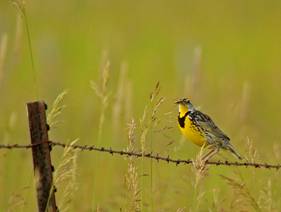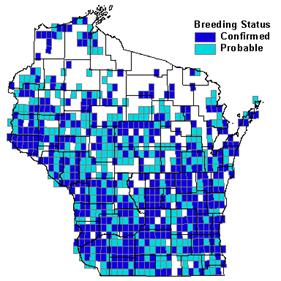

Status/Protection
- Global Rank: G5 Key to global and state ranks
- State Rank: S4B
- WBCI Priority: SGCN, PIF
Population Information
The Federal BBS information can be obtained at http://www.mbr-pwrc.usgs.gov/bbs/bbs.html by clicking on Trend Estimates and selecting the species in question. All estimates are for time period (1966-2005).
- Federal Breeding Bird Survey (WI): significant decline
- Federal Breeding Bird Survey (BCR 23): significant decline
- Federal Breeding Bird Survey (BCR 12): significant decline
- WSO Checklist Project: significant decline (1983-2007)
Life History
- Breeding Range: Throughout eastern U.S. west to the Great Plains south through Mexico, Central America and n. South America (Lanyon 1995).
- Breeding Habitat: Idle Cool-season Grassland, Idle Warm-season Grasslands, Hay, Pasture, Fallow Field, Dry Prairie, Dry-mesic Prairie, Wet-mesic Prairie, Oak Opening, Grassland-shrub, Southern Sedge Meadow and Marsh.
- Nest: Ground.
- Nesting Dates: Early May – Late July.
- Foraging: Ground glean.
- Migrant Status: Short-distance Migrant.
- Arrival Dates: late February - March.
- Departure Dates: mid-September – early November.
- Winter Range: S. Wisconsin through S. U.S.
- Winter Habitat: open country including fields and marshes.
Habitat Selection
Eastern Meadowlarks are a dominant species in pastures, idle short-medium height grasslands, old field, Grassland-shrub, dry-mesic prairie and oak savannah. They prefer medium density, high litter layer, with some forb content and few shrubs (5% or less) although they will tolerate up to 30% shrubs (Sample 1989 and Sample and Mossman 1997). Eastern Meadowlark pairs may be attracted to open grasslands as small as 20 acres (8 ha), although larger acreage is needed to sustain a viable population (Sample and Mossman 1997). In Wisconsin, the Eastern Meadowlark usually prefers more moist grasslands than Western meadowlarks (Lanyon 1953). Eastern Meadowlarks nest usually in fairly dense vegetation (Lanyon 1995).
Habitat Availability
Pastures with light grazing, hayfields with delayed mowing, and managed idle/CRP fields with the appropriate vegetation structure are important for maintaining the Eastern Meadowlark population in Wisconsin (Renfrew and Sample 2002). While these habitats are common throughout the state, they are also vulnerable to conversion to row crops and development. Idle grassland, Grassland-shrub, dry-mesic prairie, and oak savannah are uncommon and also vulnerable to conversion, fragmentation, and succession to shrubs and trees if not properly managed. Many native prairies are too small and isolated to maintain Meadowlark populations on their own (Sample and Mossman 1997). With so little native grassland left in tact, habitat availability will be dependent upon the intensity of agricultural practices and amount of land enrolled into CRP. The more intensive the agriculture (row crops, frequent hay cuttings, fewer fallow fields) the less available habitat there will be for Eastern Meadowlarks.
Population Concerns
Historically the Eastern Meadowlark was very common in the southern half of the state (northern half was heavily forested). They spread throughout the state with the increase of deforestation and are still found statewide where suitable open habitat exists (Robbins 1991). However, Wisconsin breeding bird surveys have shown a significant decline since the 1960’s (Sauer et al. 2003). A probable cause of the decline is the intensification of agricultural practices and lack of large scale native prairies causing a significant reduction in habitat availability (Sample and Mossman 1997). A compromise between agricultural needs and the preservation of habitat is necessary to maintain the habitat needed for the population to stabilize or rebound.
Recommended Management
Grassland restoration and management for Eastern Meadowlarks should seek to create large patches of habitat with a variety of successional stages and types (Hull 2003). It is best to delay mowing until mid to late July to avoid nest destruction (Sample and Mossman 1997). Fields left idle, like CRP fields, are good substitutes for native prairie. However; managers should periodically disturb these fields (3-5 years) to limit woody encroachment and to increase forb diversity (Hull 2003). Moderate grazing levels are compatible with this and other grassland bird species (Hull 2003, Sample and Mossman 1997). Eastern Meadowlarks are susceptible to human disturbance at the nest especially during the incubation stage (Lanyon 1995).
Research Needs
Continued population monitoring is needed to continue documentation of population status. Due to their nearly identical appearance, the extent of hybridization with Western meadowlark is unknown. Data is also needed on possible effects of cowbird parasitism (Lanyon 1995). Continuation of productivity studies are important to determine and better model the future population trends and better identify habitats that are resourceful for Eastern Meadowlarks (Kershner et al. 2004).
Information Sources
- Richard Henderson, WI DNR
- Baicich, P.J., and Collin J. O. Harrison. 1997. A Guide to the Nests, Eggs, and Nestlings of North American Birds. Second Ed. Academic Press.
- Wisconsin Breeding Bird Atlas: http://www.uwgb.edu/birds/wbba/
- North American Breeding Bird Survey: USGS Patuxent Wildlife Research Center
- Effects of Management on Grassland Birds: Eastern Meadowlark
- Managing Habitat for Grassland Birds: A Guide for Wisconsin
References
- Hull , S. D. 2003. Effects of management practices on grassland birds: Eastern Meadowlark. Northern Prairie Wildlife Research Center, Jamestown, ND. Northern Prairie Wildlife Research Center Online. http://www.npwrc.usgs.gov/resource/literatr/grasbird/eame/eame.htm (Version 12DEC2003).
- Lanyon, W.E. 1953. Meadowlarks in Wisconsin, Part 1. Historical and Ecological Aspects of Distribution. Passenger Pigeon. 15:99-112.
- Lanyon, W. 1995. Eastern Meadowlark (Sturnella magna). In the Birds of North America, No. 160 (A. Poole and F. Gill eds.). The Birds of North America, Inc., Philadelphia, PA.
- Kershner, E. L., J.W. Walk, and R. E. Warner. 2004. Postfledging Movements and Survival of Juvenile Eastern Meadowlarks (Sturnella Magna) in Illinois. The Auk. Vol: 121 pgs. 1146-1154.
- Renfrew, R. and D. W. Sample. 2006. Bobolink (Dolichonyx oryzivorus). In: Cutright, N. , B. Harriman, and R. Howe, eds. Atlas of the Breeding Birds of Wisconsin. Wisconsin Society for Ornithology.
- Robbins, S. D., Jr. 1991. Wisconsin birdlife: Population and distribution past and present. Madison, WI: Univ. Wisconsin Press.
- Sample, D.W. 1989. Grassland Birds in Southern Wisconsin: habitat preference, population trends, and response to land use changes. University of Wisconsin, Madison. M.S. Thesis.
- Sample, D. and M. Mossman. 1997. Managing Habitat for Grassland Birds: A guide for Wisconsin. Wisconsin Department of Natural Resources: Madison, WI.
- Sauer, J.R., J.E. Hines, and J. Fallon. 2003. The North American Breeding Bird Survey, results and analysis 1966-2002. Version 2003. 1 USGS Patuxent Wildlife Research Center, Laurel, Maryland, USA.
Contact:
- Compiler : Jenny Herrmann, mherrmann4@wi.rr.com
- Edited : Susan M. Vos
